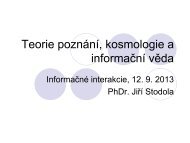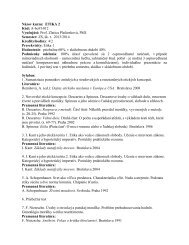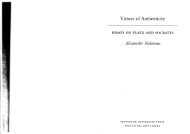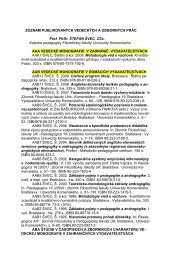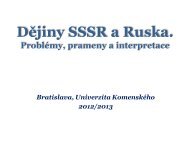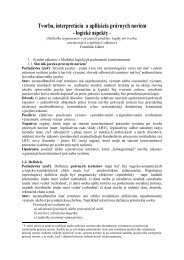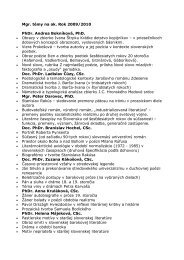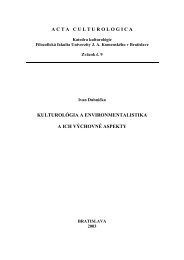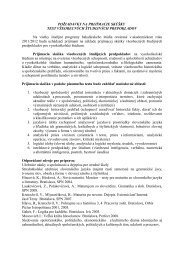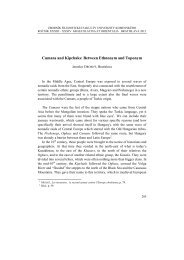Department of British and American Studies at the - Univerzita ...
Department of British and American Studies at the - Univerzita ...
Department of British and American Studies at the - Univerzita ...
Create successful ePaper yourself
Turn your PDF publications into a flip-book with our unique Google optimized e-Paper software.
Tales from India: Aravind Adiga in <strong>the</strong> Role <strong>of</strong> a Travel Guide<br />
Simona Hevešiová<br />
University <strong>of</strong> Constantine <strong>the</strong> Philosopher, Nitra<br />
The search for one‘s identity <strong>and</strong> <strong>the</strong> process <strong>of</strong> its (re)construction rank among <strong>the</strong><br />
most frequent discourses in contemporary academic discussions. The concept <strong>of</strong> identity has<br />
been scrutinized within a variety <strong>of</strong> disciplinary areas <strong>and</strong> from many perspectives, such as<br />
psychoanalytical, social constructionist or ideological but also in terms <strong>of</strong> its represent<strong>at</strong>ion in<br />
<strong>the</strong> literary form through <strong>the</strong> view <strong>of</strong> essentialists or structuralists. To large extent, <strong>the</strong><br />
preoccup<strong>at</strong>ion with identity <strong>and</strong> <strong>the</strong> self in <strong>the</strong> literary milieu has been fuelled by <strong>the</strong><br />
emergence <strong>of</strong> postcolonial <strong>and</strong> ethnic writing, which has gained prominence in <strong>the</strong> last<br />
decades <strong>and</strong> became almost fashionable to deal with (<strong>at</strong> least <strong>at</strong> Western universities). In fact,<br />
<strong>the</strong> explosion <strong>of</strong> <strong>the</strong>ories <strong>and</strong> new concepts <strong>of</strong> identity aiming to investig<strong>at</strong>e <strong>the</strong> mysterious<br />
depths <strong>of</strong> human mind triggered Madan Sarup to mark <strong>the</strong> ―widespread, pervasive fascin<strong>at</strong>ion<br />
with identity‖ as a ―symptom <strong>of</strong> postmodernity‖ (1996: 28). However, <strong>the</strong>re has been a<br />
noticeable development within <strong>the</strong> field th<strong>at</strong> has marked a shifting terrain in <strong>the</strong> studies. As<br />
Zygmunt Bauman pointed out, <strong>the</strong> ―modern ‗problem <strong>of</strong> identity‘ was how to construct an<br />
identity <strong>and</strong> keep it solid <strong>and</strong> stable, <strong>the</strong> postmodern ‗problem <strong>of</strong> identity‘ is primarily how to<br />
avoid fix<strong>at</strong>ion <strong>and</strong> keep <strong>the</strong> options open‖ (Bauman 1996: 18).<br />
Slovak <strong>Studies</strong> in English, Vol. 3, 2011 – Identity in Intercultural Communic<strong>at</strong>ion<br />
LITERATURE<br />
In general, <strong>the</strong> self has been exposed to a crucial <strong>and</strong> dram<strong>at</strong>ic transform<strong>at</strong>ion since its<br />
(re)evolution which has contributed to <strong>the</strong> alter<strong>at</strong>ion <strong>of</strong> its essential characteristics. It has gone<br />
from being marked as homogeneous <strong>and</strong> unified to being viewed as transitory <strong>and</strong><br />
polysemous. The idea <strong>of</strong> a coherent, centered <strong>and</strong> integr<strong>at</strong>ed identity has disappeared <strong>and</strong> been<br />
replaced by its flexible, fragmented <strong>and</strong> ambiguous counterpart. With <strong>the</strong> traditional views<br />
being undermined a new concept regarding identity as ―fabric<strong>at</strong>ed, constructed, in process‖<br />
(Sarup 1996: 14) has supplanted <strong>the</strong>m. Clearly, <strong>the</strong> postmodern world is a world <strong>of</strong> dynamism<br />
th<strong>at</strong> leads to <strong>the</strong> reconstitution <strong>of</strong> <strong>the</strong> self th<strong>at</strong> no longer possesses stability <strong>and</strong> fixedness.<br />
Instead, contradiction, inconsistency <strong>and</strong> hybridiz<strong>at</strong>ion take <strong>the</strong>ir place. In consequence,<br />
identity becomes a multidimensional space in which both psychological <strong>and</strong> sociological<br />
aspects have to be taken into consider<strong>at</strong>ion <strong>and</strong> which give rise to a rel<strong>at</strong>ional self. It can be<br />
viewed as a ―medi<strong>at</strong>ing concept between <strong>the</strong> external <strong>and</strong> <strong>the</strong> internal, <strong>the</strong> individual <strong>and</strong><br />
society‖ (ibid.: 28), adjusting <strong>the</strong> self-definition to <strong>the</strong> changing rel<strong>at</strong>ionships with o<strong>the</strong>rs.<br />
148



